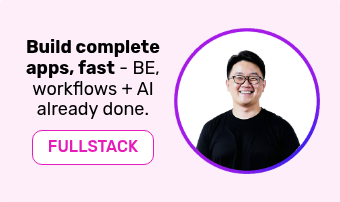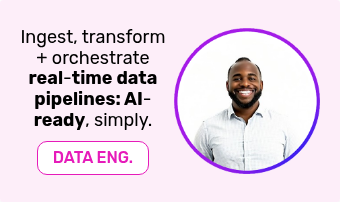The industrial sector stands on the brink of a new era, powered by advancements in Generative Artificial Intelligence (AI) and technologies like Large Language Models (LLMs).
What's covered in this article 'Industrial Generative AI + LLMs: What You Need To Know':- Top-line: what LLMs, GPTs, RAG Workflow, orchestration, and Active Learning are
- How LLMs are different from Machine Learning and other AI technologies
- Key advantages of using Generative AI in industrial applications.
- Why customisation (contextualisation) is important
- Why real-time data is critical
- Why accessibility + safeguards are key
These tools are not just reshaping the boundaries of innovation and efficiency; they're redefining them. But what exactly are these technologies, and why should professionals in industrial businesses take note?
This article demystifies these concepts, providing a clear, accessible introduction to the world of industrial Generative AI and its potential within the industrial landscape.
Top-line: What are LLMs, GPTs, RAG Workflows, and Active Learning?
- Large Language Models (LLMs) are advanced AI systems capable of understanding and generating human-like text and, increasingly, images, video and audio. It enables you to have a conversation with a machine or your data sets, uncovering optimisations and much more.
- What's the difference between an LLM and a GPT? An LLM (Large Language Model) is a broad category of AI models designed to understand, generate, or translate text based on large datasets, whereas a GPT (Generative Pre-trained Transformer) is a specific type of LLM created by OpenAI (think vacuum vs. a hoover).
- Retrieval-Augmented Generation (RAG) Workflows enable you to train and customise generic LLMs using data and information from your business. A critical component for industry, this enables you to train an LLM on your business, goals, sites, machinery, personnel, use case to deliver highly-customised responses to queries, thereby ensuring accuracy and relevance.
- Orchestration in AI refers to the process of coordinating and managing the deployment, integration, and interaction of various artificial intelligence (AI) components within a system or business.
- Active Learning is a process where the LLM identifies gaps in its knowledge or areas where it's uncertain and seeks out new data to learn from, making it continually smarter and more efficient.
How LLMs are Different from Machine Learning and Other AI Technologies
While traditional Machine Learning (ML) focuses on analysing data and making predictions based on historical patterns, LLMs and similar technologies excel in generating new content and solutions.
This generative capability allows them to not just predict what's going to happen next, but to innovate, creating new things or generating insights that haven't been explicitly programmed into them. It's like the difference between a calculator that can only solve problems it's been specifically designed for and a mathematician who can think creatively to tackle new challenges.
What are the key Advantages of Using Generative AI in Industrial Applications?
The application of Generative AI in the industrial sector offers a host of advantages.
It can automate complex decision-making processes, provide users with novel insights, generate innovative solutions to challenges, highlight problems, predict needs before they become critical, and much more - the limit is only the data that's going into it.
By harnessing the power of LLMs and related technologies, industries can achieve higher efficiency, reduced downtime, and foster an environment of continuous innovation.
The 3 important considerations for Industrial Generative AI:
1) Why Customisation (Contextualisation) is Important
Customisation, or contextualisation, is critical in ensuring that the solutions and insights generated by AI are directly applicable to the specific needs and challenges of an industrial business.
A one-size-fits-all approach rarely works in complex industrial environments, where every operation has its unique parameters, machinery, geography, staffing, objectives, weather, etc. - the variables are significant and need accounting for. Therefore, tailoring LLMs to understand these nuances will significantly enhance its effectiveness and impact and is why broad, generic models, (like ChatGPT or Gemini), will never be able to provide an industrial business with useful (or actionable) optimisation insights about their specific business.
2) Why Real-time Data + Real-Time Analysis is Critical
Real-time data integration is vital for keeping industrial Generative AI models effective.
It allows systems and users to react to changes and challenges as they happen, ensuring that the insights and solutions they provide are always based on the most current information. This real-time responsiveness is crucial for operational efficiency and can significantly mitigate risks and downtime.
It's in this area that 99.9% of current industrial Generative AI solutions fall down - and why Rayven is different. Without real-time data collation and processing, Generative AI can only ever be used after the fact. This may give value, but you might as well be using a BI platform.
3) Why Accessibility + User Management are Key
Making Generative AI tools accessible to a wide range of professionals across industrial businesses is essential for unlocking their full potential. However, this accessibility must be balanced with robust safeguards to protect sensitive data and operational integrity - you don't want to give everyone the ability to change operational processes using a single prompt!
In most modern businesses, users often have to interact with numerous interfaces and dashboards, so one of the challenges for industrial Generative AI adoption is to create a new home for all your existing data visualizations, alerts, reports, virtual controls - whatever - where you can add conversational analytics interfaces. A complete, all-in-one application has significant advantages as it gives users the context they need to ask the right questions and uncover the things that will make a material difference to industrial operations in the moment, but it does limit the number of platforms available to do it.
Industrial Generative AI represents a frontier of opportunity for the industrial sector and by understanding and embracing these tools, businesses can enhance their operations, drive innovation, and remain competitive in a rapidly evolving landscape.
Rayven is an all-in-one real-time data, AI + IoT platform with unique industrial Generative AI and custom application building capabilities. We deliver an easy-to-use, codeless toolkit that anybody can use to integrate, ETL and analyse all their data in real-time; build custom workflows and automations; leverage Machine Learning and predictive analytics; create, train, and deploy custom LLMs bespoke to their needs; and create the interfaces, alerts and reports that frontend users need to optimise, innovate and create.
Get everything you need to succeed with industrial Generative AI today and build custom AI applications fast and affordably: speak to us now to find out more and get started.




















































